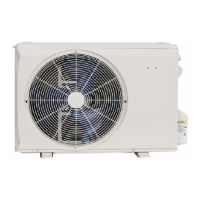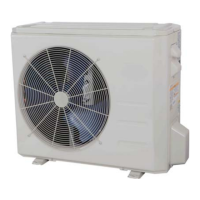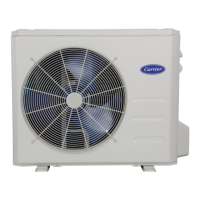Do you have a question about the Carrier 38MHRCQ18AA3 and is the answer not in the manual?
Warning about electrical hazards during installation and servicing.
Warning about explosion risks from pressurized gas mixtures.
Caution against practices that could damage equipment.
Defines DANGER, WARNING, and CAUTION for safety information.
Instructions for power and communication wiring connections.
Warnings regarding wiring practices and local codes.
Guidelines for selecting appropriate refrigerant line sizes.
Considerations for extended refrigerant line installations.
Procedure for achieving a deep vacuum in the system.
Step-by-step process for triple evacuation.
Details on various protection mechanisms for the unit.
Explains FAN, COOLING, HEATING, AUTO modes and their rules.
Procedure to manually activate the defrost mode.
Covers Drying mode, forced operation, auto-restart, leakage detection, heating.
Warnings regarding capacitor discharge before troubleshooting.
Troubleshooting steps for EEPROM parameter errors.
Steps to resolve communication errors between units.
Diagnosis and solution for zero crossing detection issues.
Troubleshooting for abnormal indoor fan speed conditions.
Procedures for diagnosing indoor and outdoor fan motor faults.
Troubleshooting sensor open/short circuits.
Diagnosis and solution for refrigerant leakage detection.
Troubleshooting steps for overload current protection.
Diagnosis for IPM or IGBT over-current protection faults.
Troubleshooting voltage protection errors.
Diagnosis for compressor top high-temperature protection.
Troubleshooting inverter compressor drive errors.
Procedures for checking critical system components.
Method for checking compressor winding resistance.
Procedure to test IPM continuity.
Method for measuring fan motor winding resistance.
Service port pressure values for cooling operation.
Service port pressure values for heating operation.
Steps to disassemble specific outdoor unit sizes.
Steps to disassemble the size 24K outdoor unit.
Resistance values for T1, T2, T3, T4 sensors.
Resistance values for T5 sensor.
Warning about electrical hazards during installation and servicing.
Warning about explosion risks from pressurized gas mixtures.
Caution against practices that could damage equipment.
Defines DANGER, WARNING, and CAUTION for safety information.
Instructions for power and communication wiring connections.
Warnings regarding wiring practices and local codes.
Guidelines for selecting appropriate refrigerant line sizes.
Considerations for extended refrigerant line installations.
Procedure for achieving a deep vacuum in the system.
Step-by-step process for triple evacuation.
Details on various protection mechanisms for the unit.
Explains FAN, COOLING, HEATING, AUTO modes and their rules.
Procedure to manually activate the defrost mode.
Covers Drying mode, forced operation, auto-restart, leakage detection, heating.
Warnings regarding capacitor discharge before troubleshooting.
Troubleshooting steps for EEPROM parameter errors.
Steps to resolve communication errors between units.
Diagnosis and solution for zero crossing detection issues.
Troubleshooting for abnormal indoor fan speed conditions.
Procedures for diagnosing indoor and outdoor fan motor faults.
Troubleshooting sensor open/short circuits.
Diagnosis and solution for refrigerant leakage detection.
Troubleshooting steps for overload current protection.
Diagnosis for IPM or IGBT over-current protection faults.
Troubleshooting voltage protection errors.
Diagnosis for compressor top high-temperature protection.
Troubleshooting inverter compressor drive errors.
Procedures for checking critical system components.
Method for checking compressor winding resistance.
Procedure to test IPM continuity.
Method for measuring fan motor winding resistance.
Service port pressure values for cooling operation.
Service port pressure values for heating operation.
Steps to disassemble specific outdoor unit sizes.
Steps to disassemble the size 24K outdoor unit.
Resistance values for T1, T2, T3, T4 sensors.
Resistance values for T5 sensor.
| Brand | Carrier |
|---|---|
| Model | 38MHRCQ18AA3 |
| Category | Air Conditioner |
| Language | English |












